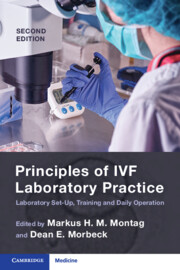Book contents
- Principles of IVF Laboratory Practice
- Principles of IVF Laboratory Practice
- Copyright page
- Contents
- Contributors
- Foreword
- The Evolution of IVF Practice
- Section 1 Starting a New Laboratory and Training Protocols
- Section 2 Pre-procedure Protocols
- Section 3 Gametes
- Section 4 Insemination/ICSI
- Chapter 21 General Insemination for IVF
- Chapter 22 Conventional IVF with Short Co-incubation
- Chapter 23 Technical Aspects of ICSI for Ejaculated Spermatozoa
- Chapter 24 Set-Up and Adapted Protocol for Piezo-ICSI
- Chapter 25 Sperm Selection for ICSI by Morphology
- Chapter 26 Sperm Selection for ICSI by Viability
- Chapter 27 Artificial Oocyte Activation for IVF
- Section 5 Fertilization Assessment
- Section 6 Embryo Assessment: Morphology and Beyond
- Section 7 Embryo Cryopreservation
- Section 8 Embryo Transfer
- Section 9 Quality Management
- Index
- References
Chapter 27 - Artificial Oocyte Activation for IVF
from Section 4 - Insemination/ICSI
Published online by Cambridge University Press: 07 August 2023
- Principles of IVF Laboratory Practice
- Principles of IVF Laboratory Practice
- Copyright page
- Contents
- Contributors
- Foreword
- The Evolution of IVF Practice
- Section 1 Starting a New Laboratory and Training Protocols
- Section 2 Pre-procedure Protocols
- Section 3 Gametes
- Section 4 Insemination/ICSI
- Chapter 21 General Insemination for IVF
- Chapter 22 Conventional IVF with Short Co-incubation
- Chapter 23 Technical Aspects of ICSI for Ejaculated Spermatozoa
- Chapter 24 Set-Up and Adapted Protocol for Piezo-ICSI
- Chapter 25 Sperm Selection for ICSI by Morphology
- Chapter 26 Sperm Selection for ICSI by Viability
- Chapter 27 Artificial Oocyte Activation for IVF
- Section 5 Fertilization Assessment
- Section 6 Embryo Assessment: Morphology and Beyond
- Section 7 Embryo Cryopreservation
- Section 8 Embryo Transfer
- Section 9 Quality Management
- Index
- References
Summary
The implementation of intracytoplasmic sperm injection (ICSI) in the field of assisted reproduction has allowed fertilization in couples with previous fertilization failure. However, complete fertilization failure after ICSI shows a prevalence of up to 3%. Moreover, low or moderate fertilization (<30%) can be observed for some patients. In such cycles of bad prognosis, the underlying problem is most likely related to a failure of oocyte activation. In vivo, a sperm-derived enzyme mediates the physiological stimulus of the complex process of oocyte activation. In vitro, a complete fertilization failure can eventually be compensated by several artificial oocyte activation (AOA) techniques, all of which aim for an increase in internal Ca²⁺. AOA is only applied with the proper indication and not as a routine method. The lack of standardized AOA methodologies led to the development and launch of a ready-to-use AOA solution and the number of publications dealing with AOA is constantly increasing. This chapter describes a proven protocol for AOA that has been used in clinical practice for more than two decades.
- Type
- Chapter
- Information
- Principles of IVF Laboratory PracticeLaboratory Set-Up, Training and Daily Operation, pp. 201 - 206Publisher: Cambridge University PressPrint publication year: 2023



